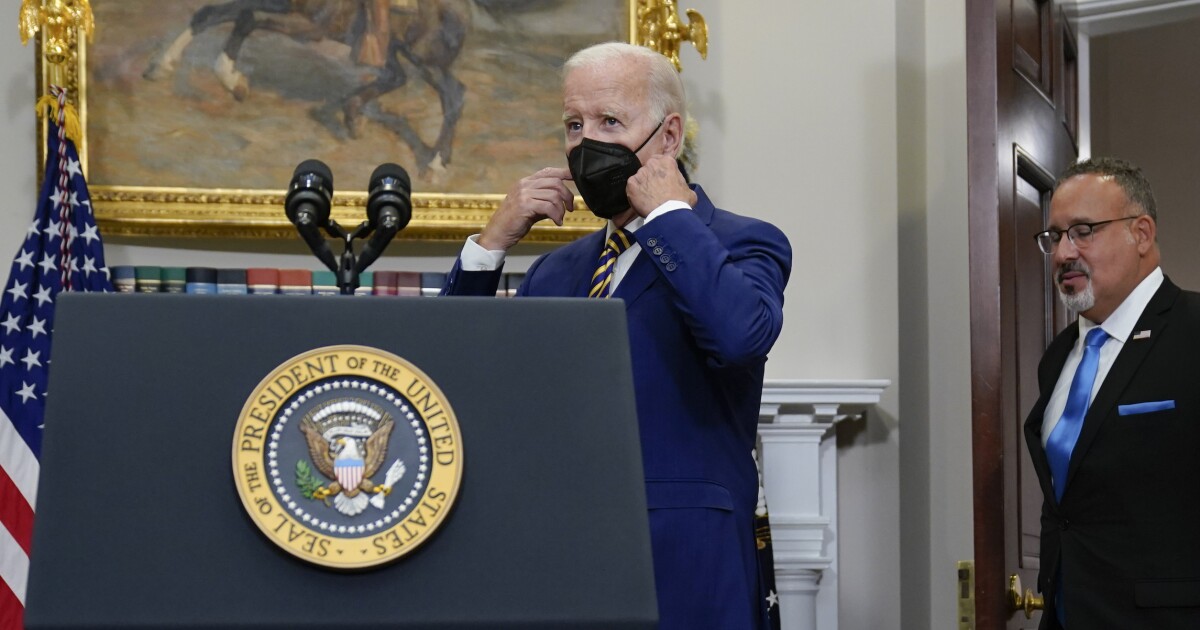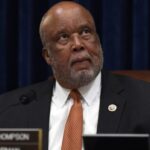

The Biden administration cited the COVID-19 pandemic as justification for its $300 billion student loan-shifting program, continuing a pattern of mentioning the virus in some situations and ignoring it in others.
Biden’s Education Department said the Higher Education Relief Opportunity for Students, or HEROES, Act of 2003 gives it the power to waive student loans due to a national emergency, that emergency being COVID-19, and Biden was careful to reference the pandemic in his remarks about the program.
BIDEN RECEIVED MILLIONS FROM HIGHER EDUCATION SECTOR BEFORE LOAN FORGIVENESS PROGRAM
“These targeted actions are for families who need it the most — working- and middle-class people hit especially hard during the pandemic making under $125,000 a year,” he said.
But at other times during his remarks, Biden spoke about the pandemic in the past tense, saying, “We responded aggressively to the pandemic to minimize the economic impact of the harm that COVID imposed on individuals, families, and businesses,” and later, “We’ve wound down pandemic relief programs like the ones for unemployment insurance and small businesses. It’s time we do the same thing for student loans.”
Some analysts have said the administration’s legal justification is weak and could be struck down by the courts if anyone can establish standing to sue.
The OLC memo on Biden’s order cancelling student debt is weak. The rationale is COVID emergency, but it does not even mention Roberts Court rulings against eviction moratorium & vaccine mandate.
I don’t see this order surviving a legal challenge.https://t.co/ePFtkIVJ4M
— Jed Shugerman 🇺🇦 (@jedshug) August 24, 2022
The White House has argued at other times that the pandemic is over, such as in May when it argued that Title 42 should be lifted for that reason. Masks haven’t been required inside the West Wing since March, and just last week, the administration signaled it will soon stop footing the bill for COVID-19 vaccines, tests, and treatments.
A reporter asked press secretary Karine Jean-Pierre about the apparent discrepancy on Thursday.
“We used the HEROES Act because there are going to be some people when we lift the pause who are still going to suffer,” Jean-Pierre responded. “They are still going to have a little bit of a hard time. And so that’s one of the reasons that we made this decision.”
At the same time, the Biden administration is acknowledging the end of the pandemic as an emergency by saying this will be the last student loans payment pause extension and that payments and interest will begin accruing again in January 2023, nearly three full years after the pause began.
While Biden has said “America is back to work
,” denied that the country is in a recession
, and touted unemployment rates’ near-record lows
, Jean-Pierre said that “there are still some folks who need a little bit more help. Both can be true.”
Brian Miller, a fellow at the American Enterprise Institute, said the administration is “absolutely” being inconsistent in its pandemic policies.
“We are now in the midst of an emergency of policy convenience, as the public health emergency declaration grants the administration powers and flexibilities that it does not want to surrender,” said Miller, also a professor of medicine and business at Johns Hopkins University.
The loans program is for anyone with student debt who makes less than $125,000 for an individual or $250,000 as a household, and allows up to $10,000 per borrower to be shifted onto taxpayers, or $20,000 for any borrowers who received Pell Grants in college. It is estimated to cost at least $300 billion in total. Some 43 million people have student loans, representing about 13% of the total population.
Unemployment rates spiked during the early days of the pandemic but were much higher for blue-collar people who didn’t attend college. The unemployment rate peaked at 8.4% for workers with at least a bachelor’s degree, compared to 17.6% for those who only graduated from high school. College graduates still enjoy a lower unemployment rate today at just 2%.
Biden may be following in his predecessor’s footsteps in using the HEROES Act to take action on student loans, albeit at a far different point in the pandemic. President Donald Trump cited the act to begin the student loans payment pause in March 2020, using the same justification that Biden is now using to back the loan-shifting program.
Administration officials have also drawn an analogy to other pandemic-era programs in justifying the cancellation, especially the Paycheck Protection Program.
“Republicans didn’t complain when certain small businesses during the pandemic got extraordinary financial relief without having to pay back those loans,” U.S. Domestic Policy Council Director Susan Rice told reporters Wednesday, again using “pandemic” in the past tense. “Some businesses needed it, and other businesses didn’t need it. This is the same principle.”
CLICK HERE TO READ MORE FROM THE WASHINGTON EXAMINER
Yet the PPP was designed from the start for loans to be forgiven in some cases, which is unlike student loans.
Critics have said the White House is only making the move now in order to increase voter turnout and push the final pause extension beyond the midterm elections, but Biden administration officials insist the recovery is ongoing.
“Let’s not forget what has happened the last couple of years, if you think about the pandemic, how people are still recovering from the pandemic,” Jean-Pierre said. “We’re trying to make sure that people still have a little bit of breathing room, especially as the pause is going to be lifted at the end of this year.”





